Intel's Core i7 870 & i5 750, Lynnfield: Harder, Better, Faster Stronger
by Anand Lal Shimpi on September 8, 2009 12:00 AM EST- Posted in
- CPUs
New Heatsinks and Motherboards
LGA-1156 processors use a different heatsink than both LGA-1366 and LGA-775 chips.
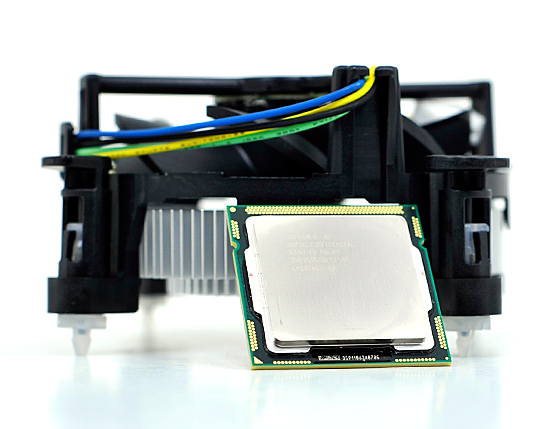
Lynnfield and its cooler
As the numbers would imply, the LGA-1156 heatsink has a larger footprint than LGA-775 but smaller than LGA-1366.
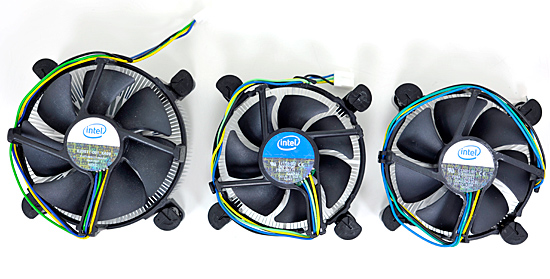
From Left to Right: Retail LGA-1366 Cooler, Retail LGA-1156 Cooler, Retail 45nm LGA-775 Cooler
The retail LGA-1156 is actually much closer to the 45nm LGA-775 retail cooler than the LGA-1366 retail HSF:
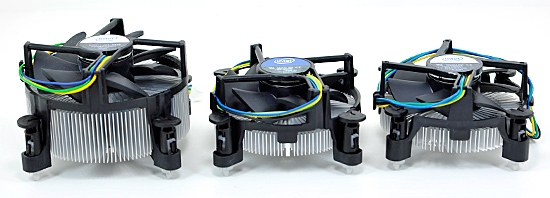
As you'll see later on in the article, the retail cooler isn't very good for heavy overclocking. Power users will want something a little bigger:
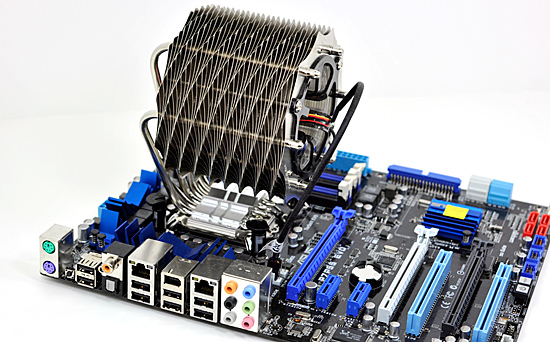
The Lynnfield/P55 launch is huge. Virtually every single motherboard manufacturer has a P55 board available. Prices range from ~$110 - $300 depending on the number of bells and whistles.

Gigabyte's ultra high end UD6 (left) and Gigabyte's lower end micro-ATX UD4 (right)
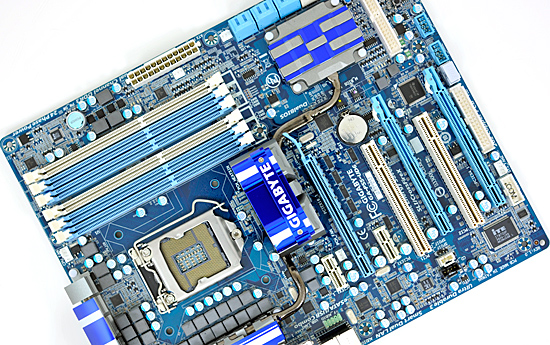
Gigabyte's high end UD6 comes with 6 DIMM slots like its X58 brethren.
Micro-ATX is increasing in popularity and we actually have some good options this time if you're trying to build a smaller Lynnfield system. Combined with Lynnfield's excellent idle power (the lowest of any quad-core we've ever tested), this could make for an unusually potent HTPC.
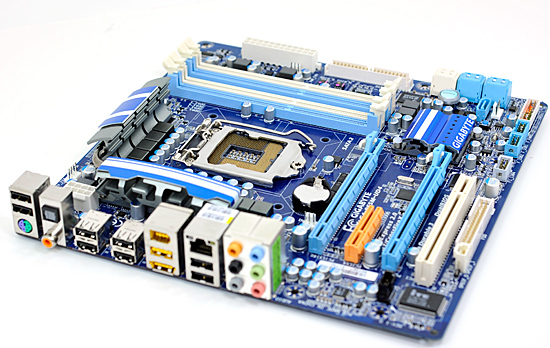
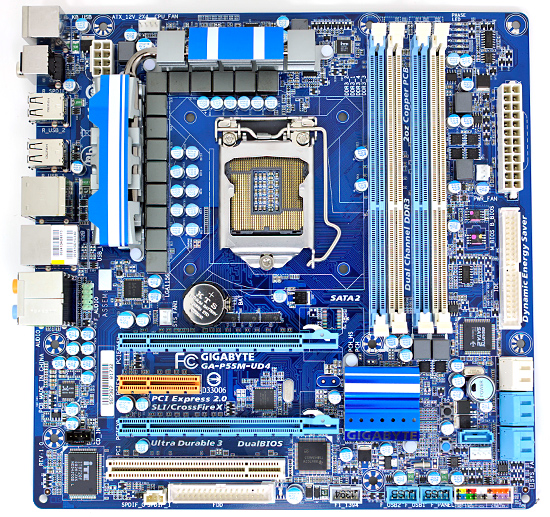
A closer look at Gigabyte's micro-ATX P55M-UD4
The only thing we're really missing is a good mini-ITX Lynnfield board. But perhaps the manufacturers will wait until we have on-package graphics before going down that route...
One More Time: New H55 Boards Next Year
As I subtley implied at the end of the last section, Intel is bringing on-package graphics to Nehalem starting in Q4 of this year:
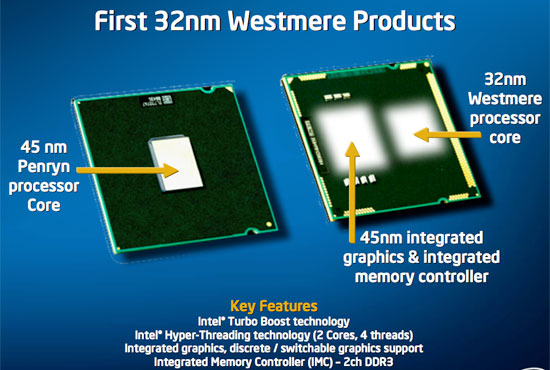
The 32nm Nehalem shrink, codenamed Westmere, will be available with a 45nm Intel graphics core on the processor's package. This graphics core is an evolution of what's currently in the G45 chipset and not Larrabee (although eventually that will change). From what I've heard, this is actually going to be Intel's first reasonably good integrated graphics core.
With the graphics on-package, there needs to be an interface from the processor socket to video output located on the motherboard. As you can see from the P55 motherboards that are launching today: none of them have this video out. Granted there aren't any CPUs out to take advantage of it either.

No DVI/HDMI/VGA out...yet
Early next year (or maybe even late this year) we'll see a new breed of LGA-1156 motherboards with video output, designed for use with these Westmere IGP parts. Rumor has it that these motherboards will use Intel's H55 chipset.
Lynnfield early adopters need not worry, 32nm quad-core processors won't be out for at least a year.










343 Comments
View All Comments
Seramics - Wednesday, September 9, 2009 - link
So what's the big deal here? I dun tink its that impressive, just good. While S196 of 750 look to outcompete the "way" more expensive $245 of AMD's 965, the truth is that the mobo that you need to pair the 750/860/870 is far from being competitive. P55 is severely stripped down and it is only slightly cheaper than their X58 counterpart. So wht if 750 is cheaper than 965 by about %50? Did you just buy the cpu only? Ppl shud at least look at the CPU+mobo price because they both come together. Truth is, when you take into account mobo price, 750 is far from outcompete 965. Added up, I think its only about balanced. The 750 is a better CPU, but it also cost more. In comparison to their socket 1366 partner, socket 1156 system cost a little less, but they are also inferior a little bit. So what's special them? Sure, there are better turbo and better thermal performance. For me, that is all that is good about the 1156 CPU. For enthusiast, socket 1366 is the way to go.jnr0077 - Friday, July 27, 2012 - link
i have a i5 750 chip cost £100 a gigabyte GA-P55A-UD6 cost £100 as it has six ram slots 16gb max radeon hd 4850 i love this mobo i cant fault it for the price i find it is a brilliant upgrade for cost i spent £250 considering the price of shops build you own pc you get what you put in :) very happy with the i5 750 1156 socket windows score on basic 500gb 7200 is 5.9 sweet 7.9 with a ssd :) can anyone tell me what the amd 965 hit on base score as i will never DV8 to amd intel 4 me allways :)hob196 - Wednesday, September 9, 2009 - link
Hi,Thanks for another great article.
I figure that having PCI-e on chip would be great to reduce the latency. Any thoughts about plugging non graphics PCI-e cards into the second PCI-e slot?
I've heard some motherboards cripple the 2nd slots performance down to x1 if you plug an x1 card in the other slot (in a shared x8 environment)any evidence of this?
In case you're curious I work with digital audio in a studio environment and I'm always striving to reduce the latency of audio going through the CPU.
These days, the latency (in streaming audio) is down to how fast the CPU can push floating point plus any overhead for the buffers in the various busses you go through. e.g. A firewire sound interface adds a few ms because of the inherent buffers between CPU -> Northbridge -> Southbridge -> Firewire -> Interface.
tempestor - Wednesday, September 9, 2009 - link
Another great article Anand!You should consider a 2nd job as a novel writer! :D
lp, M.
AndyKH - Wednesday, September 9, 2009 - link
I don't really get it:It is stated that most PCIe cards don't work well with higher frequencies and that the BCLK frequency should be kept at multiples of 133 MHz, and then they overclock it using a BCLK of ~200 MHz in one instance???
Doesn't the 133 MHz requirement make it pretty much impossible to overclock?
Someone please enlighten me.
Anand Lal Shimpi - Wednesday, September 9, 2009 - link
It doesn't make it impossible to overclock, just impossible to overclock (very high) without additional voltage.Take care,
Anand
AndyKH - Thursday, September 10, 2009 - link
Thank you for the response!I see how using a higher voltage will increase switching speed of the buffers driving the PCIe bus. However, I fail to see why it would make it any less dificult for PCIe cards to cope with the increased clock frequency, unless the increased voltage is also fed to the PCIe cards (is this the case?). Otherwise I assume they would surely experience the same problems driving communication to the CPU?
Also, you write multiples of 133 MHz but overclock to 200 MHz BCLK. Shouldn't it read multiples of 33 MHz?
TotalLamer - Wednesday, September 9, 2009 - link
I really, really don't understand why Anand is so obsessed with Turbo Modes. Any enthusiast who dares call himself such is going to clock this chip to the moon, at which point Turbo doesn't do anything. So with a 4.2GHz i7 870, all you're really left with is an i7 920 with worse multi-GPU gaming performance and and a less-certain upgrade path.coconutboy - Wednesday, September 9, 2009 - link
You're assuming all enthusiasts think like you do, but the heavy majority of people (enthusiast or not) want nothing to do with a $500+ i7 870 cpu. The i7 920, 860, and i5 920 are much more attractive options.There are plenty of "enthusiasts" who instead prefer silent computers that use no fans, or people living in hot climates who focus on very low temps, or all manner of different things. On top of that, the overwhelming majority of people simply do not care about any of the aforementioned, and those people buy the heavy majority of computers.
I started OCing in 1996, and used to OC pretty heavily, but got tired of constant tweaking or seeing my well-worn parts die prematurely. Now I tend to focus on very quiet computers that have a small/moderate overclock. So taking an i5 750 or i7 860 and raising it up 200-400 MHz and leaving turbo on is very appealing to me. Also of note is the extra heat generated and the extra money I'll spend on my electric bill by having a 24/7 overclock versus turbo modes. Dig the link and scroll to the bottom-
http://www.guru3d.com/article/core-i5-750-core-i7-...">http://www.guru3d.com/article/core-i5-750-core-i7-...
review-test/10
The 13 watt increase at idle is no big deal, but 133 extra watts under load, well... it's worth the performance boost and heat to some folks, but other people (like me) look at those things as tradeoffs that need to be weighed versus reliability, cost for extra cooling, noise, my electric bill etc.
Skiprudder - Thursday, September 10, 2009 - link
I think that some of us are quite honestly getting more green conscious these days too. It's nice to have a CPU this fast that's also this energy efficient. We can get similar to OCed performance at a much smaller power envelope. I know it doesn't add up to a lot over the course of a year (less than $100 I assume), but these things add up and it saves me some dinero on the power bills!